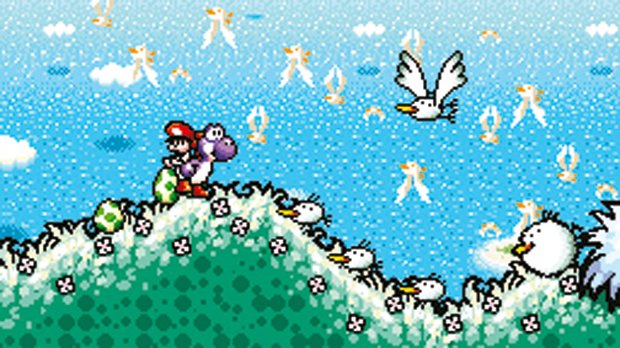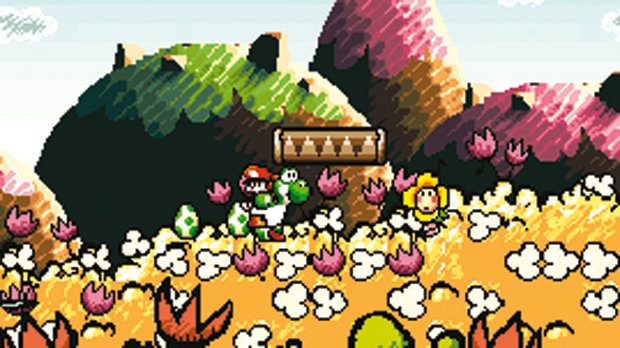Why does Yoshi's Island remain a classic, 20 years on?
First, there’s the origin story everyone knows. Following the success of Donkey Kong Country in 1994 a Super Mario World 2 prototype was rejected by Nintendo’s internal evaluation team and Shigeru Miyamoto was told to move the graphics in DKC’s pre-rendered direction. One year later, Yoshi’s Island was the result and its crayon-shaded action made it look like nothing before or since. But there’s more to the story, even if Nintendo would never discuss it out of doors: Yoshi's Island was built to carry an entire console.

In 1995 Nintendo was facing Sega and, for the first time, Sony, and Super Donkey Kong (Donkey Kong Country in the west), which was released in the same December fortnight that the PlayStation and Saturn hit the shelves, was its response to its rivals’ new consoles. Nine months later Yoshi’s Island shipped, just one week after PlayStation arrived in the UK. With its own next-gen console still another nine months from release in Japan and 18 months from release in Europe, October 1995 was Nintendo’s final push to convince players they didn’t need new hardware to get a next-generation experience.
The rejection of the first Super Mario World 2 prototype marked the point at which simply being good was no longer good enough. Movies were suddenly riddled with CGI and arcades were full of polygons and Nintendo’s biggest games had to redefine the console to fight off two 32-bit machines promising perfect arcade ports and Hollywood cutscenes.

Instead of merely mimicking Donkey Kong Country Miyamoto moved the game towards a hand-crafted style, and, by disregarding the CGI fad, he crafted something that could withstand the test of time. Even in 1995 Yoshi’s Island felt new in a way Donkey Kong Country hadn’t one year earlier. While Rare used the most powerful technology of the day to build a perfectly solid Donkey Kong platformer in a graphical style now as eye-stabbingly ugly as an episode of Reboot, Shigeru Miyamoto’s team used their new graphical style and the Super FX chip to build a living cartoon and a different kind of platformer.
Scaling enabled them to make beautiful animations and morphing sprites that would grow to fill the screen, 3D polygons created rolling platforms built to throw off slow Yoshis and the best level designers in the business put their new toys to work in the most imaginative ways. Anyone could have used a new sprite scaler to make giant bosses, but Miyamoto’s team used it to dream up a screen-filling Bashful Burt you’d have to de-pant to beat, a frog you’d fight from the inside out, a struggle for space against two Shy Guys and a potted ghost, an armoured monster who could only be beaten by having the ground removed from beneath his clanking feet and a raven who was ejected from his patchwork moon home with a prod up the bum from a wooden stake.

Back in 1995 those too-rude-for-vicar jokes were a trademark of naughty-minded Japanese developers and games like Legend Of The Mystical Ninja, Parodius and Yoshi’s Island had a keen sense of humour that’s been all but lost in today’s world. The sheer weirdness of Japanese games from the early 1990s is impossible in a globalised gaming universe in which titles cost $50 million to make. Needless to say, no creative director is ticking the box beside the kanji for “poke raven in bottom on moon to win” on a pitch document in the 21st century.
When Nintendo fans talk of the early nineties as a golden era it’s exactly because of moments like these. This was technology put to the most creative uses, not only to render screen-filling monsters, but also to give you something unique to do once they’d swollen to mammoth size. Behind it all is a sophisticated physics model that powers everything from that flutter-jump to the eggs Yoshi fires like cannonballs. Those algorithms provide the magic behind some of the best boss fights of all time, as ping-ponging eggs punch holes in wibbly-wobbly ghosts and Yoshi’s frantic flutter saves you from deadly falls at the very last second.
Weekly digests, tales from the communities you love, and more
As a result, Yoshi’s Island is perfectly unique. The box says “Super Mario World 2”, but it is no more a direct Mario World sequel than Super Mario 3D World was a sequel to Super Mario Galaxy. The first four Mario games showed a natural evolution of sorts, but for Super Mario World 2 Shigeru Miyamoto started from scratch and kicked off a kind of lunatic design that persists to this day.

Nintendo always starts from scratch with Mario, not just from game to game, but from level to level. In 1995 you’d Touch Fuzzy and Get Dizzy on one level and morph into a car, or ride a giant Koopa on another. In 2013 you’d be a giant Mario one minute and a cat the next, or racing down rapids, or carrying a friend to the flagpole. There’s always something new to try.
Even today players are finding new things to discover in Yoshi’s Island. Some of it’s useful for speedrunning, like Yoshi’s perfect flutter, which can be chained to flutter entire levels without losing altitude or the ‘gatehack’ that opens pinball bumpers from the wrong side. Others are just pure, show-off silliness, such as Yoshi’s tricky backwards run, or the glitch that launches the lizard into space during one boss fight, or the many ways to juggle eggs.
Yoshi’s Island is an inexhaustible bounty of ideas and innovation and is one of several games that Nintendo banked upon to carry it through its darkest days. From August to December in 1995 this game, Donkey Kong Country 2, Doom, Mortal Kombat 3, Final Fight 3 and Killer Instinct made Nintendo’s case, while Wipeout, Ridge Racer and Battle Arena Toshinden represented Sony, but after 20 years Yoshi’s Island stands alone: still good, still funny and still a technical masterwork.
GamesRadar+ was first founded in 1999, and since then has been dedicated to delivering video game-related news, reviews, previews, features, and more. Since late 2014, the website has been the online home of Total Film, SFX, Edge, and PLAY magazines, with comics site Newsarama joining the fold in 2020. Our aim as the global GamesRadar Staff team is to take you closer to the games, movies, TV shows, and comics that you love. We want to upgrade your downtime, and help you make the most of your time, money, and skills. We always aim to entertain, inform, and inspire through our mix of content - which includes news, reviews, features, tips, buying guides, and videos.


